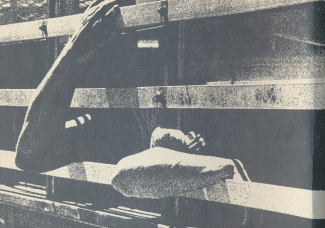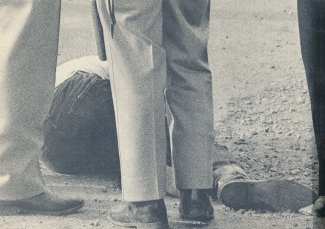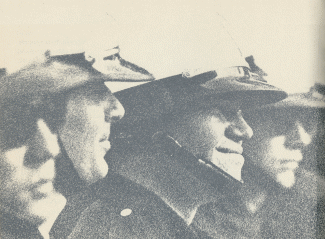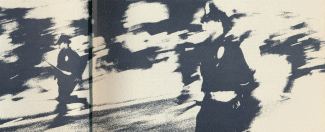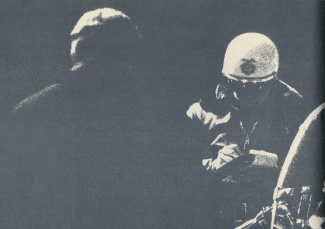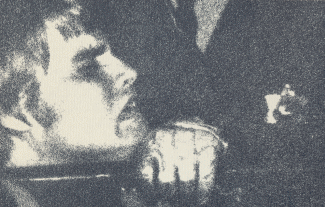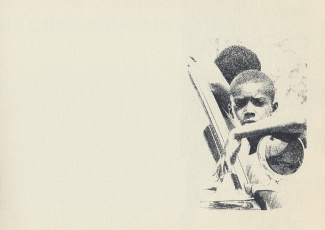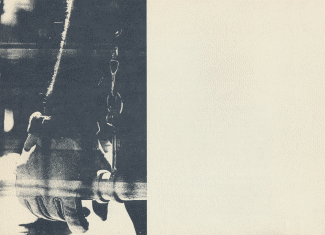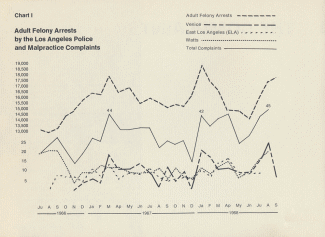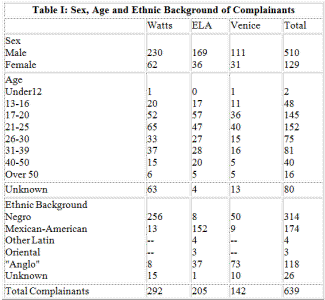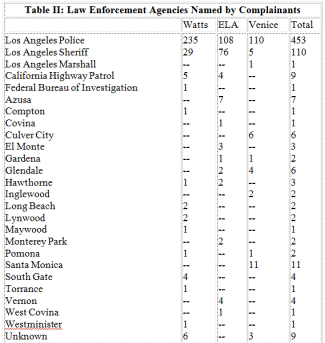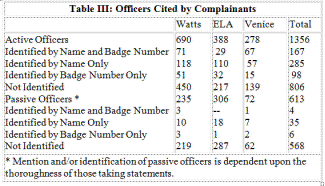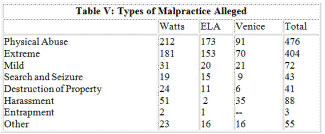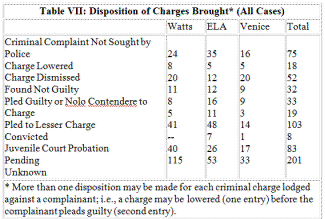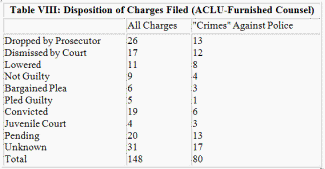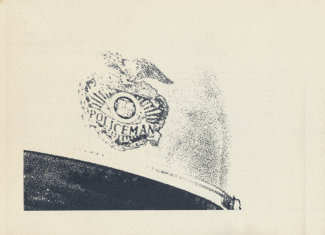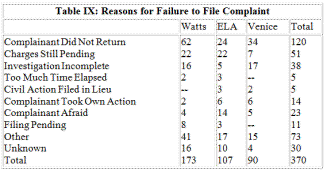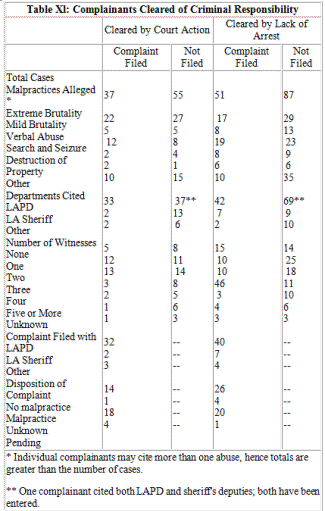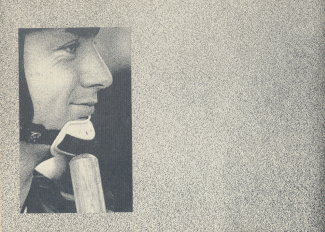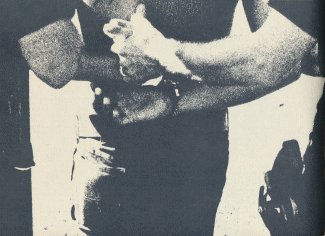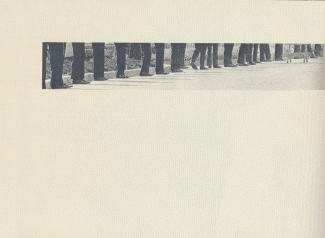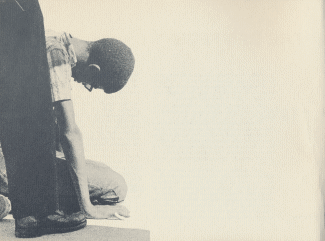
1. The Centers
The first of the American Civil Liberties Union's Police Practices Complaint Centers was opened in Watts in July, 1966, eleven months after the riots which destroyed the image of Los Angeles as a city of enlightened race relations and added a new word to the American vocabulary.
The concept of an office in the ghetto was first formulated by Mrs. Henry Schroerluke, then involved in the newly-inaugurated Watts Happening Coffee House. Talking to the young people who visited the coffee house, Mrs. Schroerluke realized that the problem of police practices in the Negro ghetto was as pressing as unemployment, long recognized as a daily frustration of the undereducated, idle men in the community.
The decision to open an office one-half block from the gutted "Charcoal Alley" was based on the fact that victims of police malpractice had to be sought out. Many or even most would not complain -- no matter how severely abused -- unless they had confidence in the agencies of government charged with investigating complaints against the police. That trust was missing. Short of confidence in official agencies, trust in a community-oriented office was the only substitute.
Furthermore, once the police practices centers had gained the trust of the community -- more easily accomplished by a ghetto office than one "downtown" -- the center directors could serve as advocates for those victimized by police abuse of authority.
The advocates' role of the directors, and the directors' identification with the community were the two most important factors: lacking faith in official complaint channels, and, in any event, unwilling to lay their grievance before the same police who had abused them, complainants would not step forward unless they could rely upon the moral -- and often, the only -- support of people from their own community.
With some five years of lobbying for a police review board behind it, and more than forty years dealing generally with abuses of police power in Southern California, the ACLU had no illusions that the opening of an office in the Negro ghetto would immediately solve the problem of police malpractice.
Malpractice exists in the ghettos and barrios of Los Angeles. The amount is unknown, estimates varying with the objectivity and experience of the observers, but to some extent, the rate of police malpractice is a constant. Some percentage of all police contacts with citizens will result in police abuse of authority. [1]
Efforts by the ACLU of Southern California and of other agencies have had no discernible effect upon official handling of complaints. The police still investigate the police; the widely noted "brother officer" concept has not been dispelled. [2]
Complaints of citizens against police officers in the County of Los Angeles' forty-eight law enforcement agencies are officially shrouded in terse form letters, in repeated refusals to grant 'public hearings, in investigations of one policeman's actions by another policeman, in refusals to release information about investigations, and in unyielding resistance to public review of departmental actions.
Theoretically, all complaints are investigated, sometimes by the "accused" officer's own superiors, sometimes by the internal investigative staff of the department. The results of these investigations are then forwarded to ranking officers in the department who review the case. If a complaint is found to have merit, the officer may be summarily punished with a light sentence. If the complaint is substantial, the charge sufficiently grave, the officer may face more severe punishment and request a departmental "trial," rather than submit to summary discipline.
In the City of Los Angeles, whose internal discipline system is the national model, this Board of Rights trial only incidentally involves the original complainant. The department assumes the role of prosecutor, and the complainant becomes merely a witness in the case presented by the department against the officer. The complainant's attorney, if he has one, may not cross-examine other witnesses nor in any other way act as an advocate for his client.
These departmental trials are purportedly open to the public. In practice, they are closed, ostensibly at the request of the "defendant" officer. The results are unpublicized beyond the department except in terse monthly memoranda circulated to a handful of elected city officials. (The department claims copies are made available to the press, but no printed evidence of this has appeared.)
The Los Angeles procedure, much copied by police departments around the country, is distinctly at odds with the recommendation of a task force of the President's Commission on Law Enforcement and the Administration of Justice:
Such procedures should include, as is now the practice in most departments, a hearing before a trial board unless the department is so small that the chief of police can himself conduct the hearing. If a board is convened, its members should be carefully screened for impartiality and lack of prejudice. The hearing should be open to the public; the complainant should have subpoena powers, be represented by counsel, and be able to see the investigative report if they [sic] so desire; there should be opportunity for cross-examination by both the officer and the complainant; if desired by either party. a transcript should be made; and the decision should be prompt -- probably no more than a month, except in unusual cases, after a complaint is filed. The trial board should render an opinion containing findings of all important facts and explaining its reasoning. [3]
The task force's recommendations were made with the specific intent of providing a public forum at which the full details of a complaint might be aired; publicity, in the opinion of the President's Commission, was the sole method of insuring accountability.
Once the decision on a complaint has been made, the complainant should be notified of the decision and the basis for it. And the public should have access to the facts of the case and the nature of the decision. Unless the public has access to reliable information, it is likely to assume the worst. On the other hand, if complainants are told of the disposition, "they would know that their complaint was not thrown in the wastebasket." [4]
Significantly, the "model" Los Angeles Police Department does not devote any great effort to make known results of its disciplinary proceedings, even though its idealized schematic flow-chart of the handling of citizens' complaints was considered an ideal for other departments by consultants to the President's Commission. [5]
This refusal to publish widely the results of citizen complaint investigations apparently is not based on a professional or technical reason. The San Mateo Sheriff's Department routinely notifies "the NAACP, American Civil Liberties Union, or other appropriate 'social action groups that might reasonably be expected to have an interest' in citizen complaints, and these groups are kept informed as the investigation proceeds." [6] Similarly, the Los Angeles Sheriff's Department will also notify "social action" groups if the complainant requests it be done.
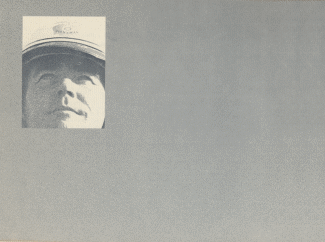
In other respects, the Los Angeles Police Department's system is the standard for other departments in the county -- and for many across the country. The department officially claims a complaint may be filed in a variety of offices, a token of the department's willingness to provide redress. But the wide access is a sham. Would-be complainants are wary of local stationhouses and have rarely any idea of the other offices or agencies where a complaint may be lodged. Those who do know are still denied "third party" intervention.
Whether they are filed with the police commission itself, at the station, with elected city officials or the district attorney, all complaints of abuse by Los Angeles police officers are automatically routed to the Internal Affairs Division, the department's internal investigative arm. (The office of the United States Attorney and the Federal Bureau of Investigation, both of which might more actively oversee local police, do little in this vein so as not to jeopardize delicate relations with departments in Los Angeles county.)
Internal Affairs, in turn, may forward complaints to the officer's precinct, to be investigated and weighed there. The most severe, or politically important complaints are retained for investigation by Internal Affairs' staff.
Based upon that investigation, the thoroughness of which is questionable at best, a disciplinary action against an offending officer may be inaugurated by the department. (Criminal prosecutions of officers who have overstepped their legal authority are virtually unknown; the district attorney too must rely heavily upon the goodwill of local police, a goodwill likely to be endangered if dirty linen is aired in public.)
The investigation, however thorough it may be, results in a terse letter: either the complaint has been sustained and appropriate action taken, or the complaint has not been sustained.
What that disciplinary action may be the complainant is not told. The results of the investigation -- as well as the charges lodged against the officer -- are simply not revealed either to the complainant or to the public. [7]
When a complaint is not sustained, the complainant is not told why, is offered no chance to rebut, and is even denied the report of investigating officers. He must take it upon faith alone that the investigation was impartial, and his complaint given serious consideration. [8]
Such a system is hardly calculated to inspire the confidence of those victimized by police. Indeed, the complaint procedure is intent upon maintaining internal departmental discipline, not in providing redress of a grievance. The system is more concerned with departmental morale than with community relations. [9]
The result of these secretive investigations has not been to the advantage of the police. A complainant who is not even told of the discipline meted out to an offending policeman is not likely to be satisfied by a two-paragraph form letter.
Your complaint of misconduct by a member of this department in connection with the death of Henry Pacheco has been reviewed by the Board of Police Commissioners.
The Board has also reviewed the findings of the investigation of this matter; and it has been determined that the officer acted lawfully in attempting to apprehend the decedent, whom he had cause to believe had committed a robbery. [10]
Two opaque paragraphs cannot explain adequately the death of a 17-year old boy, shot by a Los Angeles policeman, to members of a minority community which has come to call the police "pigs," and to believe that even homicide can be excused.
In Los Angeles county, and particularly with the Los Angeles Police Department, "A ... source of Negro hostility to police is the almost total lack of effective channels for redress of complaints against police conduct." [11]
Two years before that comment by the Kerner Commission, the Los Angeles system had been found wanting by the Governor's Commission on the Los Angeles Riots. The McCone Commission concluded in 1965:
A strained relationship such as we have observed as existing between the police and the Negro community can be relieved only if the citizen knows that he will be fairly and properly treated, that his complaints of police misconduct will be heard and investigated. and that, if justified. disciplinary action will be taken against the offending officer. [12]
In the three years since the release of the McCone Commission report, changes have been made in the Los Angeles Police Department: A deputy chief has been named to supervise community relations activities, and an increasing number of officers have made efforts to create attitudes within the department which will help to eliminate police misconduct. While the department's own self-improvement effort may yet bear fruit, as indicated in the work of the police practices centers, it does not seem possible to observe any favorable results at this time.
One thing that has not been substantially changed is the practice followed by the Los Angeles Police Department in the handling of complaints of police misconduct. Critics partisan and impartial believe that these informal practices and official procedures must be greatly modified and improved before the mutual distrust can be eased by the department's community relations program. In any event, a substantial portion of those in the community who know anything of the community relations effort believe it is still largely geared to impersonal public relations activities, and that the department has not yet found an effective way to confront the gap between the police and the minority groups that the department is supposedly serving.
The department has steadily maintained that police malpractice, and, more specifically, police brutality is relatively infrequent. Police spokesmen point to departmental records of the investigations by the Internal Affairs Division and disciplinary actions taken as proof of the department's determination to root out even the small amount which concededly exists.
Contending that police investigations and discipline are even-handed, and not unduly prejudiced in favor of uniformed personnel, spokesmen have claimed that approximately 40 percent of all complaints against officers are sustained, and the officers punished accordingly. In 1965, 445 of 979 complaints were sustained; in 1966, 415 of 953; and in 1967, 391 of 1016. [13]
These figures are for all complaints received by Internal Affairs regardless of the source. In actuality, there is a marked discrepancy in the rate of complaints sustained for those which originate from within the department, and those which come from aggrieved civilians.
Two kinds of complaints would appear to be based in large part on mutually exclusive categories: complaints of excessive force from civilians; and complaints of neglect of duty from departmental superiors. In the last three years, the rate of sustained complaints between these two categories has significantly varied. (See Table 1.)
In 1965, the department received 231 complaints of the use of excessive force, and sustained 12 -- 5.2 percent. That same year, there were 326 complaints of neglect of duty, a charge which could be made only by those who understood departmental regulations -- members of the force Of these internal complaints, 81.2 percent were sustained.


By 1967, complaints of excessive force, presumably from civilians, totalled 369; 11.4 percent were sustained. Meanwhile 192 or 79.9 percent of the 241 neglect-of-duty complaints were sustained.
These widely skewed percentages are only slightly reduced when the rates are compared to those of all complaints sustained. In 1967, Internal Affairs handled 1016 complaints, 391 (39 percent) of which were sustained. At the same time, only 10.7 percent of those sustained were complaints of excessive force, though these were approximately 37 percent of all complaints handled. Meanwhile, 49 percent of the complaints sustained were for neglect of duty, though such charges were only 24 percent of the total number of complaints handled. (See Table II.)
For whatever reasons, complaints involving internal departmental discipline are more likely to be sustained than are complaints of police use of excessive force. Moreover, punishments meted out to offending officers are comparatively light when the violation is one of physical abuse. [14]
For the people in minority communities, already lacking faith in the equality of law enforcement, these figures can hardly be reassuring. Despite departmental protestations as to the fairness and thoroughness of investigations, deprived of any participation in the actual investigation, wary at best of the police, the victim of malpractice can barely hide the bitterness born of frustration.
To a great extent, the first police practices center was opened in the hope it could help ease the bitterness of ghetto dwellers, even if the center could offer only a sympathetic ear. There was no guarantee offered by the center that it could gain vindication for the complainants; the director could, in fact, act only as an expediter of complaints, making certain that the complainant was directed to the proper office to file his complaint and that he was not turned aside by local desk sergeants.
This minimal assistance -- aside from that provided by ACLU volunteer attorneys who undertook to defend in the courts victims of police abuse of authority -- were it to ease the bitterness, might at the same time relieve the hostility of minority group members to the police. That, in turn, might help avert another Watts, even as it aided day-to-day law enforcement. [15]
Furthermore, the centers might serve as a constant prod for the police to reform their internal investigation systems, giving for the first time serious attention to citizens' complaints. The director would become an advocate for those whose complaints he took, and, in time, might become persuasive.
The first office, opened in predominantly Negro Watts in July, 1966, was followed by similar centers in East Los Angeles' Mexican-American barrio and the Venice community with its variegated Negro, Mexican-American and hippie population.

In no small measure, the three offices have become a part of the black and brown communities they serve, accepted by the residents at first cautiously, and then more openly. The office in East Los Angeles has offered space to a welfare rights organization; the former director of the Watts office -- now attending law school -- was a member of the Black Congress' Board of Directors; the Venice office has close ties with that community's self-help group, The Organizers; the directors of the East Los Angeles and Watts offices have been asked to be spokesmen for their communities in hearings before the Los Angeles City Council.
This acceptance has aided the work of the centers; the number and rate of complaints taken has increased steadily as more people have come to realize that the police practices offices are a permanent community resource.
This then is a report on the first two years of the Police Practices Complaint Centers.

